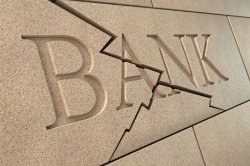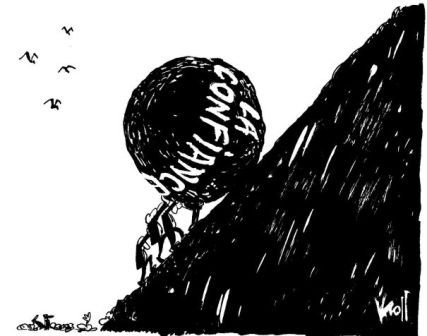
A debt economy
Despite timid signs of rebound, the global economy does not seem to be at the end of its troubles and risks being permanently weakened by the surge in unemployment and the uncertain state of health of the banking system, according to several experts. Emboldened by a slew of better-than-expected indicators, the US administration has trumpeted “the beginning of the end of the recession” while China continues to post vigorous growth. Reassured, the financial markets started to rise again. “There are signs of deceleration in the recession,” analyzes a former senior official of the International Monetary Fund (IMF) who requested anonymity. However, the situation hardly lends itself to optimism and the end of the recession will not be synonymous with vigorous growth, experts warn. Soaring unemployment will be a major test. According to the International Labor Organization, the planet could have up to 59 million additional unemployed this year compared to 2007, an increase of 31%, and the end of the recession should not reverse the trend. “In an economy which is no longer declining but which is progressing slowly, unemployment continues to increase,” warns François Bourguignon. Consequence: household income risks suffering and hampering consumption, one of the main drivers of the economy. The ability of banks to support the restart of the economy constitutes another reason for concern, particularly in Europe where companies depend closely on bank credit to finance their investments (Le Soir, Monday August 10, 2009).
(continued) 6. Remedies used by central banks and governments:
Faced with these dramatic developments, central banks and governments have sought to consolidate the banking system through a set of measures: state guarantees for bank deposits, capital contributions (TARP-US) or nationalizations (UK), temporary relaxation of accounting rules, recourse to monetary creation (policy known as “quantitative easing”) to replenish the capital of banks. Furthermore, they sought to stimulate economic activity through interest rate cuts, subsidizing the real estate market, stimulus programs (ARRA-US), and temporary tax reductions. Governments have also tackled tax evasion and trader bonus schemes.

What is the relevance of the means used?
The fight against tax havens and the taxation of bonuses appear to us to be gimmicks and we will not dwell on them, simply mentioning that the fight decreed by hard-pressed governments against tax havens is perfectly selective, aiming in particular at a European state with democracy. direct with which the large States undoubtedly have a political score to settle; it is above all a matter of scaring taxpayers who would be tempted to escape a tax pressure that has become very strong.
7. The policy of repeated and rapid reductions in interest rates is questionable. If it undoubtedly contributed to avoiding a short-term catastrophe by reducing the burdens of debtors in an economy where the debt reached a record amount ($34 trillion in the USA), it may have failed to take into account the time necessary for the first cuts have an effect, depress consumer confidence, penalize savers and retirees, and fuel inflationary risk. The longer-term effectiveness of rate cuts in a credit crunch situation is zero, as the example of Japan has shown in an even more aggressive version with rates lowered below 0.5% and relaunches which have soar the public deficit to more than 160% of GDP.
 8. The modification of accounting rules with a view to allowing banks to carry assets on their balance sheet at their theoretical value is an accounting make-up and aims to maintain a shaky banking system in which all the rotten or toxic assets are not really known ( level 3 assets). Overall, the situation of the banking system remains fragile. Thus according to certain sources, Citigroup for example would have an exposure of 135 billion USD to level 3 assets (these are illiquid positions, listed very irregularly, which have no market price and whose valuation is based on estimates from bank management).
8. The modification of accounting rules with a view to allowing banks to carry assets on their balance sheet at their theoretical value is an accounting make-up and aims to maintain a shaky banking system in which all the rotten or toxic assets are not really known ( level 3 assets). Overall, the situation of the banking system remains fragile. Thus according to certain sources, Citigroup for example would have an exposure of 135 billion USD to level 3 assets (these are illiquid positions, listed very irregularly, which have no market price and whose valuation is based on estimates from bank management).
9. Regarding aid to bail out banks , it does not allow governments to ensure that banks really reopen the credit tap. The American administration refused to nationalize banks in difficulty which would have allowed supervision of these establishments while forcing them to place the liquidity made available by the State in the economy. The latter is therefore now reduced to urging the banks to kindly support the country’s activity, even though they have benefited from government aid amounting to hundreds of billions of dollars. By unconditionally flooding the banks with liquidity, the new president of the United States has therefore sent the wrong message. The financial system is already returning to its natural propensity for excessive risk.
 Quantitative easing corresponds to pure and simple monetary creation with a view to purchasing the debt of banks or that of the State. However, the abundant liquidity put into circulation by the central banks in the United States, Great Britain and Europe is already fueling new speculative bubbles and risks causing vast inflation in a second phase, even if this is delayed by , on the one hand, the fact that these sums are not injected directly into consumption, and on the other hand, by the powerful deflationary forces linked to the explosion of unemployment and the weakness of demand.
Quantitative easing corresponds to pure and simple monetary creation with a view to purchasing the debt of banks or that of the State. However, the abundant liquidity put into circulation by the central banks in the United States, Great Britain and Europe is already fueling new speculative bubbles and risks causing vast inflation in a second phase, even if this is delayed by , on the one hand, the fact that these sums are not injected directly into consumption, and on the other hand, by the powerful deflationary forces linked to the explosion of unemployment and the weakness of demand.
10. What about real estate subsidies?
Fannie Mae, Freddie Mac and Ginnie Mae, who fueled the bad loan machine to the point that their bankruptcy will cost the US taxpayer some $400 billion, continue, since their near nationalization in 2008, to be the major players in the securitization. As a result, the risks of refinancing new loans are entirely borne by the taxpayer. And Fannie and Freddie have not tightened their credit criteria. Personal contributions of 3% remain commonplace, and with the tax credit, many loans are in fact concluded with negative personal contribution. In fact, purchases are subsidized by the State to the tune of $8,500 in tax credits. This is apparently not much, but this credit can supplement the personal contribution of borrowers, which allows them increased leverage effects. Furthermore, the quasi nationalization of securitization coupled with short rates from the FED close to zero allows banks to grant credits at rates kept artificially low, which constitutes a second subsidy, very real although hidden, which allows sellers to increase their margins. If the subsidy programs were to dry up, or if the Treasury ran out of money to meet the obligations of Fannie, Freddie and Ginnie, then prices would experience another period of decline, especially if the new wave of “ “contractual resets” brought a large number of new properties onto the market for sales following seizure.
 11. Direct aid to the economy in the form of stimulus packages, which also aimed, in the case of ARRA, to stabilize the finances of local governments, is controversial. Many economists consider the 2009 recovery entirely artificial. The dynamics that led to the subprime crisis of 2007 have not changed in any way, and the appearance of vitality of the economy is largely due to the existence of continued government stimuli. The recent bullish rally in financial markets was achieved largely through massive job cuts. But reducing staff and sacrificing research and development projects is not conducive to sustainable growth. Ultimately, the latter is essential for financial markets to continue to prosper. However, the quality of growth is currently very low because the growth in credit supply comes from the purchase of state debt by commercial banks rather than from the provision of credit to the private sector with a view to producing goods.
11. Direct aid to the economy in the form of stimulus packages, which also aimed, in the case of ARRA, to stabilize the finances of local governments, is controversial. Many economists consider the 2009 recovery entirely artificial. The dynamics that led to the subprime crisis of 2007 have not changed in any way, and the appearance of vitality of the economy is largely due to the existence of continued government stimuli. The recent bullish rally in financial markets was achieved largely through massive job cuts. But reducing staff and sacrificing research and development projects is not conducive to sustainable growth. Ultimately, the latter is essential for financial markets to continue to prosper. However, the quality of growth is currently very low because the growth in credit supply comes from the purchase of state debt by commercial banks rather than from the provision of credit to the private sector with a view to producing goods.
 12. The return of inflation
12. The return of inflation
The return of inflation is no longer excluded. The conditions are increasingly met. The American central bank promises to inject extraordinary currency liquidity for a long time to come. As for the European Central Bank, it is faced with the equally extraordinary weakness of the Greek, Spanish, Irish, Italian, French and other public accounts. Experts counter these facts with the underutilization of production chains and workers who put pressure on prices and wages. But many of these abilities have been removed and are no longer available. The marked drop in raw materials had previously given the impression of a general slowdown in prices, but this effect is ending. The one and only solution to destroy all the debt that has been created by banks and governments around the world is inflation. A massive drop in living standards would indeed be politically impractical. Inflation or even hyper-inflation, in the long term, is therefore undoubtedly inevitable. However, it could be preceded by a period of deflation, that is to say a general fall in the prices of all assets, a fall in wages associated with a massive recession. In this regard, the recent evolution of the international freight price index (predictor of future activity) is hardly reassuring. Other possibilities are a coexistence of the two phenomena in stagflation, or general inflation coupled with sectoral falls in prices and wages, or some Eurozone countries in inflation and others in deflation.
13. The weight of debt
Like the evil Pharaoh in his time, governments have put nothing aside for periods of scarcity. Now they must try to work their Keynesian magic on credit. This puts them in a weak position. For the moment, government credit is still good. The bankers who take money from governments still happily lend it back to them… But governments no longer have any room for maneuver. Even without new spending, the state debt will explode within two years to 105pc bu GDP in Great Britain, 125pc in the United States and the eurozone, and 270pc in Japan. The debt burden is heavier than it was after the Second World War, while nominal levels are similar. Global state debt reaches $45 trillion, an increase of 250pc in 10 years. Private debt is also considerable. Even if the American savings rate stabilized at 7% and was used solely to repay debt, it would take 9 years for households to reduce the debt-to-income ratio to the level of the 1980s. The similarities are striking with Japan’s situation during its “lost decade”, with one big difference: Japan could keep its head above water because it exported in a strong global economy, and it let it slide the yen. But half of the countries in the world will not be able to pursue this strategy at the same time. (to be continued)











